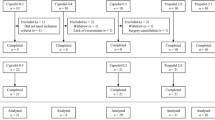Zusammenfassung
Propofol, ein relativ neues iv.-Anästhetikum mit einer extrem kurzen Halbwertszeit, das sich in Voruntersuchungen in der Pulsoxymetrie durch eine konstant hohe Sauerstoffsättigung auszeichnete und sich weiters günstig auf den intraokulären Druck auswirkt [5], wird hier dem seit vielen Jahren verwendeten Diazepam gegenübergestellt. Dazu wurden für beide Sedativa je 50 Patienten erfaßt, die bezüglich Narkoserisiko (ASA-Stufen 2–4) vergleichbar waren, bzw. nach denselben Richtlinien auf die Operation vorbereitet wurden. Propofol wurde mittels Perfusor in einer Dosierung von 0,8–3,0 mg/kg/h zugeführt. Diazepam hingegen wurde vor Operationsbeginn in einer Dosis von 5 mg langsam intravenös verabreicht.
Hauptkriterium der Beurteilung bildete die kontinuierliche Pulsoxymetrie: In der Propofol-Gruppe sank die Sauerstoffsättigung nie unter 96%, in der Diazepam-Gruppe hingegen sah man besonders in den ersten 5 Minuten nach Verabreichung einen Abfall bis auf 85%, der sich erst nach weiteren 10 Minuten auf 95% besserte. Einen zweiten Aspekt bildete die motorische Ruhe der Patienten, die besonders bei ophthalmologischen Operationen wichtig ist. In der Propofol-Gruppe traten bei keinem der Patienten Zeichen der motorischen Unruhe auf, wohl aber in der Diazepam-Gruppe bei vier Patienten, wodurch der Operationsablauf gestört wurde.
Ergebnis:
In der Propofol-Gruppe zeigte sich pulsoxymetrisch keine Hypoxygenation, weiters bestand intraoperativ völlige motorische Ruhe. In der Diazepam-Gruppe starke Hypoxygenation bei vielen Patienten, sowie Zeichen der motorischen Unruhe und eine langanhaltende postoperative Müdigkeit, die eine Mobilisierung erschwerte.
Summary
One hundred patients of comparable anesthesiologic risk (ASA classes 2–4) undergoing identical surgical procedures received either Propofol (n = 50), a new intravenous anaesthetic agent, or Diazepam (n = 50). Propofol was infused at a rate of 0.8–3.0 mg/kg/h while Diazepam was given as a slow intravenous bolus of 5 mg before surgery. All patients were monitored by continuous pulse oxymetry.
Oxygen saturation in patients receiving Propofol was never less than 96%. In contrast, saturation was seen to drop to 85% in patients receiving Diazepam, and to reattain 95% only after 10 minutes. None of the patients receiving Propofol showed sings of motor unrest while 4 patients receiving Diazepam were restless enough to hamper the procedure. None of the patients receiving Propofol developed respiratory depression. In contrast, marked respiratory depression, motor unrest, and postoperative fatigue slowing mobilization were common in patients receiving Diazepam.
Similar content being viewed by others
Literatur
Freiherr v. Hornstein W, Mertes N, Loick M, Lawin-Bruessel C, Radig C (1988) Low dose propofol for sedation during ophthalmic surgery in regional anaesthesia. 5th International Congress Belgian Society of Anesthesia and Reanimation, 87. Brussels, 14–17 Sep 1988
Debaillon-Vesque P, Buffet JP, Chaudon MP, Poitrey HF, Dhedin G (1989) Combining propofol with regional anaesthesia for cataract surgery. Cahiers d’ Anesthesiologie 37 (1): 55–56
Conrad B, Larsen R, Rathgeber J, Lange H, Stüber H, Crozier T (1990) Propofol-Infusion zur Sedierung bei Regionalanästhesien — Ein Vergleich mit Midazolam. Anästh Intensivther Notfallmed 25: 186–192
Steib A, Freys G, Jochum D, Ravenello J, Schaal JC, Otteni JC (1990) Recovery from total intravenous anaesthesia. Propofol versus midazolam-flumenacil. Acta Anaesthesiol Scand 34 (8): 632–635
Leveque M, Rakotoseheno JC, Mimouni F, Rouffy P, Egreteau JP (1987) Effets du propofol sur la pression intra-oculaire au cours de 1’ induction anesthésique. Ann Fr Anesth Réanim 6: 306–308
Kestin IG, Harvey PB, Nixon C (1990) Psychomotor recovery after three methods of sedation during spinal anaesthesia. Br J Anaesth 64: 675–681
Miniero E, Martini M, Grande L, Scesi M, Beccia F, Spinosi A (1989) General Anaesthesia in ophthalmic surgery by continuous infusion of propofol using a pump-our experience. Proceedings of the Congresso Nazionale della Societa Italiana di Anaesthesia, Analgesia, Rianimazione e Terapia Intensiva, 43 rd SIAARTI Congress, Modena 8–11 Jun 1989: 139–142
Mirakhur RK, Stanley JC (1989) Propofol infusion for maintenance of anaesthesia for vitreous surgery — comparison with isoflurane. International Anesthesia Research Society 63 rd Congress, Lake Buena Vista, 4–8 Mar 1989. Anesthesia and Analgesia 68: 197
Barale F, Hagopian F, Francois P, Girod A, Bachour K, Serri S, Stimmesse B, Royer J (1987) Propofol anaesthesia for eye surgery in the elderly patient. Symposium, Prague 29 Jan -1 Feb 1987. Annales Francaises d’ Anesthesie et de Reanimation 6: 309–312
Tremper KK, Borger SJ (1987) Advances in oxygen monitoring. Little and Brown, Boston
Monedero-Rodriguez P, Panadero-Sanchez A, Garcia-Pedrajas F, Carrera-Hueso J, Catala Bauset JC, Arroyo-Carreras JL (1991) Estudio comparativo entre tiopental y propofol en anesthesias de corta duracion. Comparative study between thiopental and propofol in short duration anesthesia. Revista Espanola de Anestesiolgia y Reanimacion 38 (3): 153–155
Brazzalotto I (1989) Effects of propofol. Annales Francaises d’ Anesthesie et de Reanimation 8 (4): 388
Lehmann EL (1975) Nonparametrics: statistical methods based on ranks. San Francisco
Author information
Authors and Affiliations
Rights and permissions
About this article
Cite this article
Holas, A., Faulborn, J. Propofol (Diprivan®) Versus Diazepam (Gewacahn®) zur Sedierung bei Ophthalmologischen Operationen in Lokalanästhesie. Spektrum Augeheilkd 7, 9–14 (1993). https://doi.org/10.1007/BF03163886
Issue Date:
DOI: https://doi.org/10.1007/BF03163886




